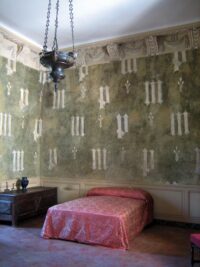As plants and animals absorb carbon dioxide during their lifetimes, they absorb the unstable isotope carbon-14 with it. When they die, the carbon exchange stops and the C14 isotopes start to decay at a steady rate. Radiocarbon dating works by measuring the amount of carbon-14 present in organic archaeological materials and comparing it to reference standards. Now for the first time, researchers have been able to radiocarbon date an inorganic pigment to date wall paintings from the Late Middle Ages. This breakthrough technique makes it possible to get absolute dates for paintings from antiquity through the 19th century, a huge boon to conservators, art historians and authenticators.
Paintings made before the 20th century usually incorporate organic ingredients like vegetable oils or egg binders, but binders are often contaminated over the years by varnishes and retouches and the carbon content is too low to test. The wood of panel paintings, the wood supports of canvas paintings, the canvas itself can be radiocarbon dated and indeed frequently are in authentication investigations, but the C14 information pertains to the date the wood or plant was harvested, not when the painting was made per se.
Murals have no organic backings or binders, so the only possible route for absolute dating are the pigments in the paint layers themselves. Most ancient pigments have no carbon content. Only carbon black, made from charcoal, has been radiocarbon dated before.
Two widespread white pigments – calcium carbonate and lead white – are carbonate-based pigments and contain carbon. Both are considered as mineral pigments, but are produced differently. Calcium carbonate (CaCO3) is a natural pigment extracted from quarries. It was formed several million years ago from micro-organisms, but due to the 14C radioactive decay of 5700 years, geological CaCO3 no longer contains enough 14C to be radiocarbon dated. Conversely, lead white is synthesized. Lead white, composed of cerussite (PbCO3) and hydrocerussite (Pb3(CO3)2(OH)2), has been artificially produced by lead corrosion since Antiquity. This corrosion process, involving metallic lead, vinegar and organic substances such as horse manure or tan bark, was also named the stack or Dutch process when mass production started from the 16th century on.
Lead white was widely used by painters from antiquity to Van Gogh, so being able to derive an absolute date from the pigment would open up all kinds of new possibilities. The trick was to develop a technique to separate the carbon in lead white that would leave it uncontaminated and testable. The research team devised a thermal separation system that heated the sample to 400 °C, high enough to break apart lead carbonates but low enough for the carbon release process to be monitored and controlled.
 Researchers deployed the process on samples of wall paintings from the 14th century dressing room of Margaret of Bavaria in the Château de Germolles in Burgundy, and fragments from the medieval rood screen of the Church of the Cordeliers in Fribourg, Switzerland. The rood screen was destroyed in 1745 and the rubble used as fill to raise the floor for a new pavement. A 1985 restoration removed the floor and recovered 14,000 painted fragments.
Researchers deployed the process on samples of wall paintings from the 14th century dressing room of Margaret of Bavaria in the Château de Germolles in Burgundy, and fragments from the medieval rood screen of the Church of the Cordeliers in Fribourg, Switzerland. The rood screen was destroyed in 1745 and the rubble used as fill to raise the floor for a new pavement. A 1985 restoration removed the floor and recovered 14,000 painted fragments.
The radiocarbon dates of three samples from the Château de Germolles are 1292–1401, 1283–1397, and 1300–1419. The nine fragments of the Cordeliers rood screen range in date from 1262 to 1630. These results are all consistent with the known history of the château and the church.
In this study, we demonstrate that it is possible to extract all the carbon from lead carbonates by thermal decomposition in order to date lead white pigments and paintings by the radiocarbon method. The synthesis process of lead white is identified according to the 14C content and we show that the 14C isotope is therefore an important marker for reconstructing the history of lead white production. The process most commonly used over time is the corrosion process occurring in a fermenting environment. Metallic lead and vinegar were placed in pots embedded in horse manure or other organic substances. By fermentation, organic substances degrade and release CO2 that carries 14C. The organic substance are thus the key component to obtain a reliable and absolute radiocarbon date. Medieval paintings are a perfect example showing that recipes reported in historical manuscripts were applied. The radiocarbon measurements date the pigment production and provides new insights into the creation of the wall paintings.